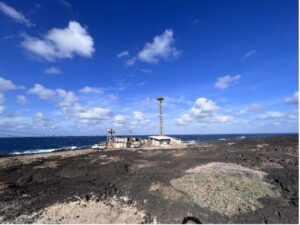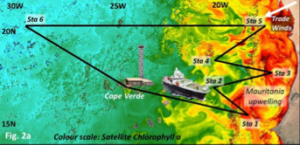Nitrogen oxides and ozone in the remote tropical Atlantic Ocean
Atmospheric nitrogen oxides (NOx = NO + NO2) are crucial controls of oxidants such as ozone (O3) and the hydroxyl radical (OH), and hence play a major role in determining atmospheric composition affecting human and environmental health. The sources and chemical cycling of NOx over the remote oceanic atmosphere remain highly uncertain, despite this region accounting for more than 70% of the Earth’s surface. This leads to uncertainty in the global oxidizing capacity as this region removes a substantial proportion of air pollutants and climate gases such as methane (CH4) and ozone (O3). For much of the surface of the planet (oceans, un-inhabited regions) there is little or no direct emission of NOx and as such, concentrations are typically very low (of the order of 10 – 100 pptv). This is a particularly crucial NOx range, in which depending on the time of year, location in the troposphere and levels of O3 and H2O, falls the O3 compensation point, a level of NOx at which there is a change from net ozone destruction to net O3 production. It is important to understand the sources (and sinks) of NOx in remote environments as changes in ozone in the background troposphere impacts the ability of countries downwind to achieve their air quality standards.

Due to the complex nature of the nitrogen oxide budget and the dominance of fresh emission sources in urban / continental regions, the best place to identify the chemical cycles which control the abundance of nitrogen oxides is in the remote marine troposphere. The Cape Verde Atmospheric Observatory (CVAO, https://amof.ac.uk/observatory/cape-verde-atmospheric-observatory-cvao/) is situated in the remote marine boundary layer on the island of São Vicente in the tropical North Atlantic Ocean and receives constant, unperturbed trade winds blowing directly off the ocean from the northeast. It has an 18 year continuous data record of many reactive gases including NO and O3 and a 7 year record of validated NO2 (Andersen et al., 2021), measured in air with a variety of origins. Levels of NOx are low (typically <50 pptv), leading to almost constant daily O3 destruction (Read et al., 2008). NOx mixing ratios peak around solar noon (at 20–30 pptV depending on season; Andersen et al., 2022), which is counter to box model simulations that show a midday minimum due to OH conversion of NO2 to HNO3, demonstrating that rapid photolysis of nitrate aerosol to produce HONO and NO2 is likely an important contributor to the observed diurnal cycle (Andersen et al., 2023).

More work is needed to understand the sources and chemistry of NOx in the remote marine environment, with the ultimate aim of allowing models to predict how remote O3 changes under future emission scenarios and subsequent changes in NOx. This project will seek to improve understanding of sources and sinks of NOx in the remote tropical Atlantic Ocean, using data from long term (and continuing) measurements of at the Cape Verde Atmospheric observatory. Data will be analysed according to the air mass origin (e.g. North America, Africa, remote Atlantic, Southern Europe), assessed using back trajectory and dispersion model calculations.
New measurements of NOx and O3 will also be taken on a research cruise in the surrounding area in summer 2026, which the student will have the opportunity to take part in. These measurements will allow the long-term measurements at Cape Verde to be put in context of the wider tropical North Atlantic Ocean and to assess the importance of natural and anthropogenic emissions from West Africa in the area nearer to the African coast.

The student will work under the supervision of Prof. James Lee, Prof. Lucy Carpenter and Dr Beth Nelson (University of York) and will be based at the Wolfson Atmospheric Chemistry Laboratories, part of the Department of Chemistry, University of York. Here, the student will develop transferrable skills in making atmospheric measurements (e.g. of NOx and O3 for ground, ship and aircraft-based measurements), chemical mechanism development and evaluation, numerical and data skills associated with model/measurement comparison and analysis of long-term trends of atmospheric gases using a variety of statistical techniques.
